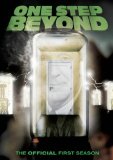“About this startling new show as a whole, we say this. When ordinary people of our real world encounter the chilling world of the unknown, when normal men and women take that one step beyond, that we think is incomprable drama, all the more memorable and amazing because these strange adventures are true, absolutely true.”
The stories from One Step Beyond were reportedly true, but to paraphrase a rather disingenuous former president, it all depends on what your definition of true is. In interviews many of the writers later admitted that much of the material came from a couple of reference books. The idea was a truly reported one, but the story was pretty much created. The series was directed and hosted by John Newland and ran from 1959 to 1961. The shows were half hour and sponsored by Alcoa. In syndication the series was often called Alcoa Presents: One Step Beyond. In 1978 the original creative team of creator Merwin Gerard and host/director Newland attempted to revise the series calling it The Next Step Beyond. But the show was not picked up.
“The amazing drama you are about to see is a matter of human record. You can believe it or not. But, the real people who lived this story, they believe it. They know. They took that one step beyond.”
The series lasted three years but led the way for a complete genre of anthology shows that explored these fantastic subjects. Many are nearly forgotten in the 50 years since. Some, like The Outer Limits and The Twilight Zone have become cultural icons. These shows had a much narrower collection of themes. Almost every episode dealt with: premonition, apparitions, or contact with the dead. One of the more interesting episodes of this first season involved the many reported premonitions of the sinking of the Titanic. Newland, at the end, talks about a book published in 1898 called Futility. I researched and discovered it was indeed true. Fourteen years before the Titanic was built, the book told the tale of a ship that hit an iceberg on its maiden voyage to New York. The iceberg struck at the exact speed and location as the Titanic had. The time was April just before midnight. The real time was April 14 at 11:40 PM. Finally, the name of the fictional ship? The Titan. It too was the marvel of human engineering and considered unsinkable so that only the minimum number of lifeboats required by law were on board. This is the kind of thing One Step Beyond was best at.
Let me ask you a question. Has anything ever happened to you that you couldn’t explain? That made you feel kind of foolish when you tried to tell somebody about it? Well, if it has, you have plenty of company, as you’ll soon see.”
And the series did have some very memorable company. In this first season alone guest stars include: Barry Atwater, Rita Lupino, Ross Martin, Werner Klemperer, Edward Pratt, Mike Connors, Patrick O’ Neal, Lester Matthews, Pernell Roberts, Joanne Linville, Julie Adams, William Schallert, Jean Allison, Cloris Leachman, and Virginia Leith. Good company indeed. This was really a first of its kind in the new age of television. Fans of those other shows will be glad they finally get a chance to get these episodes.
Video
Each episode is presented in its original full frame format. The truth is these prints are in remarkable shape for their age. The picture is usually pretty sharp. There are minimal specks and blemishes. There was obviously a good effort to present these shows in as good a condition as possible. There aren’t the expected jump edits or dirty frames. The contrast varies considerably but is often incredibly sharp on these black and white presentations. I’ve watched a ton of old films and television shows in my days, and I find these to be extraordinary at times, better than average at others. Of course, they still are 50 years old and wouldn’t compare favorably to today’s standards, but I think anyone who would enjoy this kind of show will be very happy with the results here.
Audio
The Dolby Stereo presentation isn’t nearly as good as the video. There is a decided harshness to it all. You’ll experience plenty of high end splatter. The dialog is scratchy, particularly S sounds. You’ll also hear a lot of the film hiss and crackle. Still, it’s not likely to ever look better.
Special Features
The 22 episodes can be found on 3 single-sided discs. The extras are on the first 2.
Disc 1:
Alcoa Openning: (:50) This is the titles sequence with the Alcoa mention.
Main Title Sequence – 1990’s version: (44) There was a CG title sequence added for the 90’s syndication package. It’s nothing mind blowing, merely a tour through a house.
Promo: (:28)
Extended Pilot: There is a 5 minute overall introduction to the series from the first episode available here.
Disc 2:
Archival Audio Interview With Writer Don Mankiewicz: (5:44) It’s audio only against a static screen and subtitles. The writer answers a few questions about the show and where the story ideas came from.
Final Thoughts:
“There are over 150,000 cases of some phenomena and I assure you that somewhere something unexplained is happening to someone at this very moment, hair raising, dramatic, even humorous.”
That’s a lot of weird and crazy stuff going on. In the end, however, it wasn’t this collection of loosely based on truth stories that stole the imaginations of the television audiences around the world. But it might have paved the way for one that did. The very next fall the planet was introduced to The Twilight Zone by Rod Serling, and television would never be the same. Serling’s twisted ending morality tales appear timeless. Fifty years later we’re still haunted by those tales of imagination. “So you see, dead men do tell tales.”






